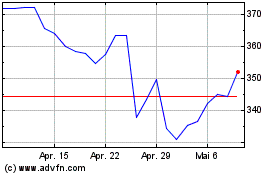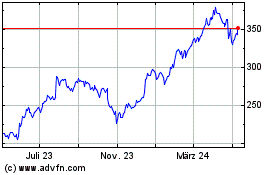Glen Barton Helped Steer Caterpillar Through a Strike That Sapped Union
04 November 2016 - 3:29PM
Dow Jones News
By James R. Hagerty
Glen Barton, an engineer who grew up on a Missouri farm, helped
lead Caterpillar Inc. through a six-year battle with the United
Auto Workers that weakened the union's influence over pay and work
rules.
He served as a group president of the Peoria, Ill.-based company
from 1990 until 1999, then spent five years as chairman and chief
executive of the maker of construction and mining equipment. When
the UAW went on strike in 1994, Caterpillar deployed a temporary
workforce including office staffers and welders bused to Illinois
from as far away as Alabama. After 17 months, the strike
crumbled.
Caterpillar credited Mr. Barton with leading the adoption of a
Six Sigma program to boost quality.
Mr. Barton died Oct. 24 at age 77.
In the early 1990s, Mr. Barton and other Caterpillar executives
argued that the company's labor costs threatened its ability to
compete, particularly with Japan's Komatsu Ltd. Mr. Barton said
labor costs at Caterpillar were 25% to 30% higher than those at
Komatsu, an estimate disputed by the union.
Donald Fites, Mr. Barton's predecessor as CEO, led the struggle
with the UAW. The battle helped establish the now widespread
"two-tier" wage system, in which companies hire new workers at
wages far below those for employees protected by past union
contracts. It also helped end "pattern bargaining," in which big
auto and equipment makers all granted roughly the same terms to the
UAW.
Glen Barton was born Aug. 20, 1939, in Alton, Mo., and grew up
on a farm. "We'd get up at six o'clock in the morning and milk the
cows," he said in an interview recorded by Caterpillar. "We had to
milk them at 4:30, 5 o'clock in the afternoon also, regardless of
(whether) there was a basketball game that night or not." He
graduated as valedictorian of his high-school class, earned a civil
engineering degree at the University of Missouri in 1961 and then
joined Caterpillar as a trainee.
"When you become CEO you sort of say, I am not going to screw
this up," he said in the interview. He was pleased that the company
remained profitable during a downturn early in his term as CEO.
"We had the groundwork in place, that when the economy picked up
in 2004 we just raced from the $20 billion level of sales to the
$30 billion level," he said. Sales jumped from $22.81 billion in
2003 to $30.31 billion in 2004 and $36.34 billion in 2005.
In his retirement, his charitable activities included heading a
fundraising campaign for the Red Cross. He also contributed to
educational causes and the Peoria Zoo.
Mr. Barton is survived by his wife of 23 years, Phyllis "Polly"
Hayes, as well as four children, nine grandchildren, a sister and a
brother.
Write to James R. Hagerty at bob.hagerty@wsj.com
(END) Dow Jones Newswires
November 04, 2016 10:14 ET (14:14 GMT)
Copyright (c) 2016 Dow Jones & Company, Inc.
Caterpillar (NYSE:CAT)
Historical Stock Chart
Von Jun 2024 bis Jul 2024

Caterpillar (NYSE:CAT)
Historical Stock Chart
Von Jul 2023 bis Jul 2024
